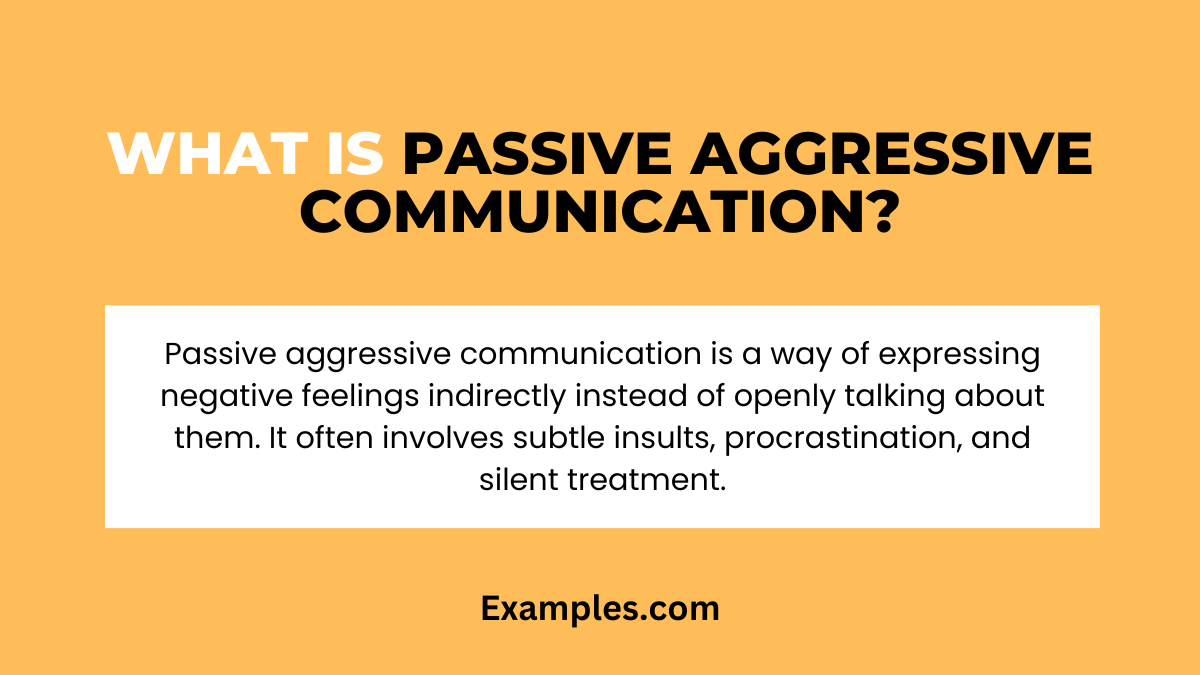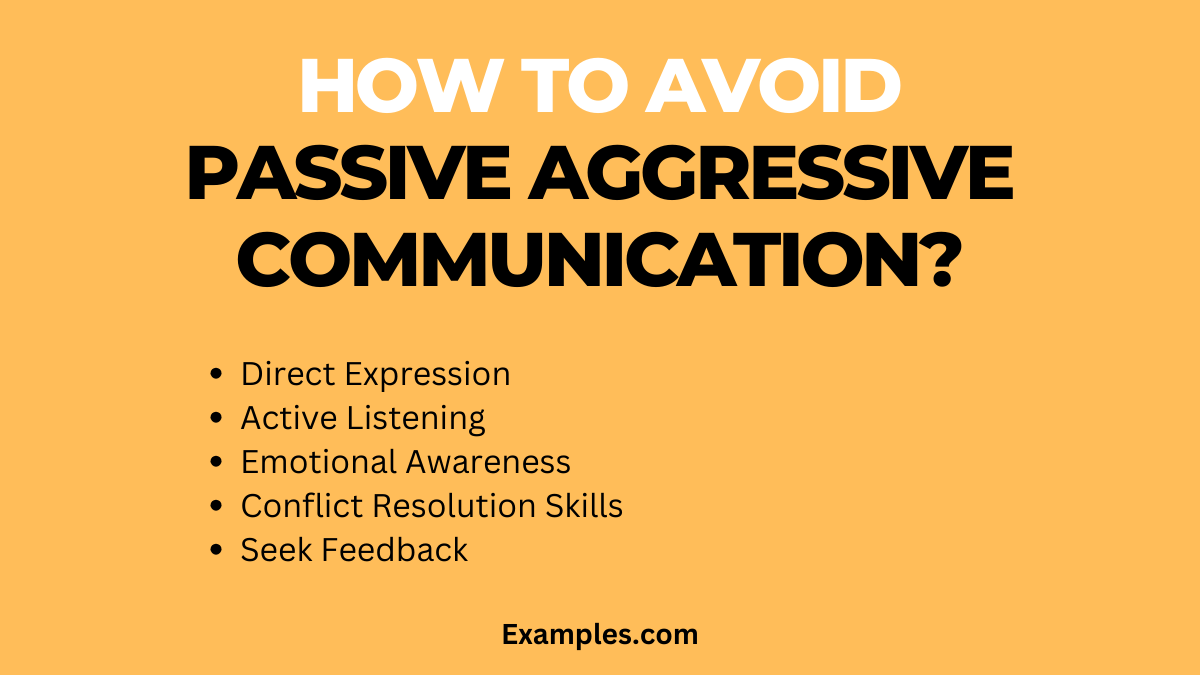How to Avoid Passive Aggressive Communication?
Navigate the Complex World of Interpersonal Communication with Our Comprehensive Guide on How to Avoid Passive Aggressive Communication. This detailed resource offers Practical Examples and Effective Strategies for recognizing and circumventing passive-aggressive behaviors in both personal and professional settings. Learn to communicate more Openly and Directly, enhancing your Relationships and fostering a more Positive Environment. Whether you’re dealing with Workplace Dynamics or Personal Relationships, this guide is your key to Healthy Communication and Conflict Resolution.
What is Passive Aggressive Communication?

Passive aggressive communication is a way of expressing negative feelings indirectly instead of openly talking about them. It often involves subtle insults, procrastination, and silent treatment. This type of communication can be confusing and frustrating for others, as the true feelings and intentions behind the words or actions are hidden. Passive aggressive behavior is a common way of avoiding direct confrontation and expressing discontent without direct communication.
How to Avoid Passive Aggressive Communication?

Avoiding passive-aggressive communication requires self-awareness and active effort. It involves recognizing the signs of passive aggression in oneself and consciously choosing more direct and clear forms of expression. This involves stating your needs, feelings, and opinions openly and respectfully, without resorting to indirect or underhanded methods like sarcasm or backhanded compliments. Developing assertive communication skills is key, as it allows for honest and straightforward interaction while maintaining respect for others. Avoiding passive aggression also means being open to receiving direct feedback and being willing to engage in open, two-way communication.
Avoiding passive-aggressive communication is essential for healthy interactions. It involves:
- Direct Expression: Be clear and direct in expressing your thoughts and feelings. This helps in avoiding misunderstandings that often lead to passive-aggressive behavior.
- Active Listening: Pay close attention to others’ words and emotions. Active listening fosters understanding and discourages indirect communication.
- Emotional Awareness: Being aware of your own emotions helps in expressing them healthily. Recognize when frustration or anger might lead to passive-aggressive responses.
- Conflict Resolution Skills: Develop effective conflict resolution strategies. Addressing issues directly and constructively can prevent the need for passive-aggressive communication.
- Seek Feedback: Regularly asking for feedback on your communication style can help you become more aware of and adjust any passive-aggressive tendencies.
Adopting these strategies can significantly reduce the tendency to engage in passive-aggressive communication, leading to more open and effective interactions.
Examples for How to Avoid Passive Aggressive Communication
To effectively avoid passive-aggressive communication, embrace clear, honest, and direct interaction. Understand and express your emotions in a straightforward manner. Active listening and empathy are key in understanding others and preventing miscommunications. Setting clear boundaries and expectations, and addressing issues head-on can significantly reduce passive-aggressive tendencies. Foster a communication environment where everyone feels safe to express their true thoughts and feelings.
- “I feel upset when meetings are missed without notice. Can we discuss how to improve this?” – Directly addresses an issue without indirect criticism.
- “I appreciate your efforts, but I need more timely responses to proceed effectively.” – Offers constructive feedback without hidden insults.
- “Let’s set a specific deadline for this task to ensure timely completion.” – Clearly communicates expectations to prevent procrastination.
- “I noticed you seemed quiet today. Is there anything on your mind?” – Encourages open dialogue and checks for underlying issues.
- “It frustrates me when decisions are made without my input. Can we talk about it?” – Expresses feelings directly, avoiding the silent treatment.
- “I value your opinion. What do you think about this approach?” – Promotes inclusion and direct communication.
- “Can we discuss a solution together for this recurring problem?” – Seeks collaborative conflict resolution rather than indirect resistance.
- “Your comment earlier seemed a bit off. Can you clarify what you meant?” – Addresses potential sarcasm or subtle insults directly.
- “I’m finding it hard to understand your perspective. Can you explain more?” – Seeks clarity to avoid ambiguous communication.
- “I’ve noticed some tasks are consistently late. How can we address this?” – Discusses a pattern of behavior directly instead of through indirect criticism.
How to Avoid Passive Aggressive Communication at Workplace?
Avoiding passive aggressive communication in the workplace is key to maintaining a healthy, productive environment. Here’s how to achieve this:
- Promote Open Dialogue: Encourage an atmosphere where employees feel comfortable sharing their thoughts and concerns openly. This reduces the need for indirect communication.
- Set Clear Expectations: Clearly defined roles and responsibilities help prevent misunderstandings that can lead to passive aggression.
- Foster a Feedback Culture: Regular, constructive feedback sessions can address issues before they escalate into passive-aggressive behaviors.
- Conflict Resolution Training: Equip staff with conflict resolution skills to handle disagreements effectively and directly.
- Lead by Example: Management should model direct and respectful communication, setting the tone for the rest of the team.
- Encourage Team Building: Strong team relationships, built through team-building activities, can reduce the likelihood of passive-aggressive dynamics.
By implementing these strategies, a workplace can significantly reduce instances of passive aggressive communication, leading to better teamwork, clearer communication, and a more positive work environment.
Examples for How to Avoid Passive-Aggressive Communication at Workplace
Avoiding passive-aggressive communication in the workplace involves promoting direct, clear, and respectful dialogue. It’s essential to create an environment where employees feel comfortable expressing their thoughts and concerns openly. Encouraging honest feedback, addressing conflicts directly, and fostering a positive work culture are key. Regular training and leading by example can also play a significant role in mitigating passive-aggressive behaviors, ensuring a more harmonious and productive workplace.
- “I noticed your report was late. Can we discuss how to improve time management?” – Directly addresses the issue without implying blame.
- “Let’s have regular check-ins to ensure we’re all on the same page.” – Proposes a solution to prevent misunderstandings.
- “I value your input. Do you have any suggestions for this project?” – Encourages open communication and values team input.
- “I’m finding it difficult to understand your perspective. Can you explain further?” – Seeks clarity to avoid misinterpretation.
- “Let’s address the issue directly and find a solution together.” – Promotes collaborative problem-solving.
How to Avoid Passive Aggressive Communication in Writing?
Avoiding passive aggressive communication in writing is crucial for clear and effective correspondence. Here are key strategies:
- Be Direct and Clear: Use straightforward language to express your thoughts and needs. Avoid vague or ambiguous phrases that can be misinterpreted.
- Positive Tone: Maintain a positive and respectful tone, even when addressing issues or providing feedback.
- Avoid Sarcastic or Ambiguous Language: Refrain from using sarcasm or double meanings, which can be interpreted as passive-aggressive.
- State Intentions Clearly: Clearly articulate your intentions to avoid misunderstandings. If you are giving feedback, be constructive and direct.
- Proofread for Tone: Reread your messages before sending to ensure the tone is professional and devoid of hidden frustrations.
By implementing these techniques, you can effectively reduce passive aggressive tones in your written communication, ensuring clarity and professionalism.
Examples for How to Avoid Passive Aggressive Communication in Writing
To avoid passive aggressive communication in writing, focus on clarity, positivity, and directness. Ensure your language is straightforward and your intent is clear, avoiding sarcasm or ambiguous phrases. Adopt a professional tone, and use ‘I’ statements to express personal views without sounding accusatory. Re-reading messages for tone and inviting feedback can also help in maintaining clear, effective communication. Address issues directly, avoiding blame language, and consider follow-up conversations for complex issues.
- “I need your report by Friday to meet our deadline.” – Directly states the requirement without implying blame.
- “I appreciate your efforts but let’s focus on improving accuracy.” – Provides constructive feedback while acknowledging the recipient’s work.
- “Could you clarify this point for a better understanding?” – Seeks clarification without sounding accusatory.
- “I’m concerned about the project’s progress. Let’s discuss possible solutions.” – Expresses concern and invites collaboration.
- “Thank you for your email. To clarify, here’s what I meant…” – Responds to potential misunderstandings with clarity.
In conclusion, avoiding passive-aggressive communication requires embracing directness, clarity, and empathy. By fostering an environment of open dialogue, addressing conflicts directly, and using clear, respectful language, we can overcome the barriers created by passive-aggressive behavior. This approach not only enhances personal interactions but also contributes to a healthier and more productive communication climate, whether in personal relationships or professional settings.



